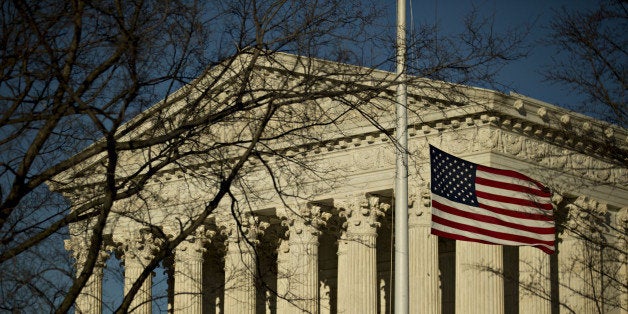
The death of Justice Antonin Scalia will undoubtedly have significant ramifications for many cases currently pending before the Supreme Court. Arguably, however, the stakes are among the highest in the Court's upcoming consideration of a Texas law restricting abortion access. That case, Whole Women's Health v Hellerstedt, will be heard on March 2, and is likely the most significant abortion case to come before the Court since Planned Parenthood v Casey in 1992.
First, some background.
At issue in Whole Women's Health is a Texas law that restricts access to abortion in two ways: it requires physicians performing abortions to have admitting privileges within 30 miles of the clinic where they perform abortions, and it requires facilities where abortions are performed to be set up as ambulatory surgical centers. The Fifth Circuit upheld both of these restrictions, prompting women's health clinics in Texas to appeal to the Supreme Court. They argue that the restrictions are wholly unnecessary, noting that (1) abortion is an incredibly safe medical procedure (the complication rate from legal abortion is less than one half of one percent); (2) admitting privileges are simply unnecessary because, in the rare circumstance that a woman needs hospital care following an abortion, emergency rooms will treat her whether or not the outpatient physician has such privileges; and (3) requirements that abortion facilities meet the stringent standards of ambulatory surgical centers ignore the reality that early abortion care simply does not require such facilities, and that such requirements in fact only serve to increase abortion costs and delay access to abortion care.
As multiple scholars have aptly pointed out, however, the issues in Whole Women's Health go far beyond the question of the constitutionality of the Texas law. The real issue before the Court is the interpretation of Casey's "undue burden" standard. Casey permitted states to restrict abortion access provided that the restriction did not -- "in purpose or effect" -- place an undue burden on the woman seeking an abortion. Here, the Court is faced with questions of whether the Texas restrictions constitute such an undue burden, whether the restrictions actually advance women's health, and significantly, whether they are required to under Casey.
In short, the case is a referendum on Casey, and is poised to be the most significant abortion case in decades.
Before Justice Scalia's death, many assumed that the Court's four liberal Justices -- Justices Breyer, Ginsberg, Sotomayor, and Kagan -- would vote to strike down the Texas law, and the four conservative justices -- Chief Justice Roberts and Justices Thomas, Scalia, and Alito -- were likely to vote to uphold the law (though there is some speculation regarding this bloc, as five justices had previously voted to block enforcement of the restrictions while the case was pending). Justice Kennedy, as always, was the presumed wildcard. His record on reproductive rights cases is mixed: he voted to uphold Roe v. Wade in the 1992 Planned Parenthood v Casey (thus affirming a woman's right to access abortion), but authored the opinion upholding the so-called Partial Birth Abortion Ban in the 2007 Gonzales v. Carhart (thus restricting access to certain abortion procedures).
If Justice Kennedy again joins the conservative bloc in Whole Women's Health, the Court will be split 4-4. A split on the Court means that the lower court's decision will stand -- in the Texas case, that means the Fifth Circuit's decision upholding the Texas law will remain in place. There are several important dimensions to such a result.
First, the immediate: If the Fifth Circuit's decision stands, the abortion restrictions will go into effect in Texas. These restrictions will have a very real impact on women's lives. It is estimated that the new law's requirements will force at least 75 percent of the Texas clinics currently providing abortion services to close and will almost certainly deter others from opening. Women in Texas will thus face (at best) long delays in receiving abortion care and (at worst) a complete lack of actual access to such care. Such delays are significant. While it is undisputed that abortion is one of the safest medical procedures, the risks of complications from abortion do increase as a pregnancy advances. Such a ruling could also prompt other states to follow in Texas's footsteps, further restricting abortion access around the country. Given that roughly 90 percent of U.S. counties lack an abortion clinic, additional clinics shuttering their doors has very real ramifications for women's health.
Second, the longer term: Allowing the Fifth Circuit's decision to stand would mean that the Fifth Circuit's restrictive interpretation of Casey's undue burden standard also stands -- including its determination that courts need not examine whether abortion restrictions actually protect women's health, but can instead just accept the assertions of state legislatures that they do. That's a dangerous precedent for women's health, and a dangerous cession of power to state legislatures.
Finally, it raises questions of legitimacy: it means that the Supreme Court will not have established a precedent that would have nationwide value. The Fifth Circuit's decision will bind courts in the Fifth Circuit -- but only courts in the Fifth Circuit.
As a practical matter, this means that abortion law would differ depending on which federal circuit a woman lives in -- that is, it will depend on which area of the country she lives in.
A case in point: the Seventh Circuit recently heard a case involving the requirement under Wisconsin law that physicians who perform abortions have admitting privileges at local hospitals. This time, the Circuit Court did not uphold that restriction (and in fact, criticized the Fifth Circuit for coming to the opposite conclusion). If an eight-member Supreme Court decision splits 4-4 on Whole Women's v Hellerstedt, a woman living in Wisconsin (the Seventh Circuit) and a woman living in Texas (the Fifth Circuit) could have dramatically different access to the identical medical procedure. The physicians who perform abortions would likewise be subject to vastly different restrictions and possible penalties.
And so, after a decade-long moratorium on taking abortion cases, just as the Supreme Court prepares to hear what could be one of the most profound abortion cases to date, there exists the distinct possibility that the Court's decision could be that there's no decision after all.
